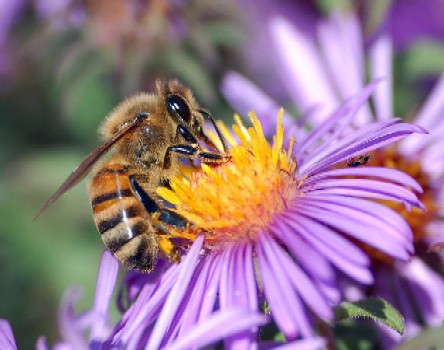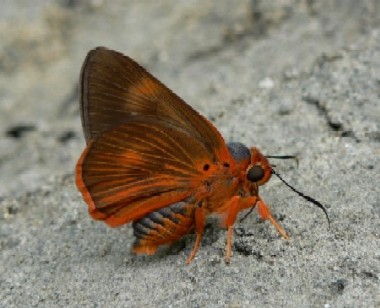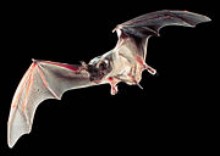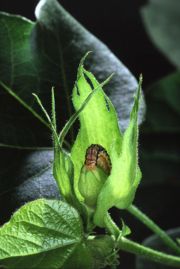Navigation
Key Pollinators for Food Security and Biodiversity To Be Protected By $27 Million Global Environment Facility Project
A new project worth $26.45 million has been launched by the Global Environment Facility (GEF) to better protect bees, bats and birds that are essential to the world’s crop production.
 |
| A European honey bee (Apis mellifera) extracts nectar from an Aster flower using its proboscis. Tiny hairs covering the bee's body maintain a slight electrostatic charge, causing pollen from the flower's anthers to stick to the bee, allowing for pollination when the bee moves on to another flower. Photo by John Severns. Wikipedia |
A new project worth $26.45 million has been launched by the Global Environment Facility (GEF) to better protect bees, bats and birds that are essential to the world’s crop production.
The unique five-year project -- “Conservation & Management of Pollinators for Sustainable Agriculture through an Ecosystem Approach”, which will be implemented through the United Nations Environment Programme (UNEP) -- will help ensure food security through the protection of the key pollinator species.
The project is coordinated by the Food and Agriculture Organization on United Nations (FAO) and will be executed through partnerships with the Governments of Brazil, Ghana, India, Kenya, Nepal, Pakistan and South Africa in collaboration with stakeholders from different environment and agricultural communities at national and international level, including ministries, research institutions, agencies, academia, NGOs, private sector and farming
communities.
The GEF will contribute $7.8 million and leverage another $18.65 million from other partners which include multilateral organizations, Governments and academic institutions.
In recent months, the decline and even collapse of important pollinator populations like honey bees have been detailed in scientific journals and in news reports.
 |
| Orange Awlet an uncommon butterfly found in the forests of Assam, India. Photo by MV Nair of the Butterfly Northeast. |
Pollinators such as birds, bees, butterflies, bats and even mosquitoes are essential for food production because they transfer pollen between seed plants-impacting 35 per cent of the world’s crops. As a result, farmers and consumers alike strongly rely on these “pollinators” for their very survival.
Along with providing an essential service to human populations, pollinators also have a key role in maintaining other ecosystem services including ensuring biodiversity and helping nature to adjust to external threats such as climate change. For these reasons, pollinators are known as a “keystone species” in many terrestrial habitats.
The main threats to pollinators can be linked to disease, pesticide use, habitat loss and degradation, monocultures and the introduction of exotic species, causing concern not only among agricultural producers but conservationists as well.
The UNEP/GEF project ‘Conservation & Management of Pollinators for Sustainable Agriculture through an Ecosystem Approach’ will contribute to the conservation, sustainable use and management of pollinators by:
1. Developing and implementing tools, methodologies, strategies and best management practices for pollinator conservation and sustainable use;
2. Building local, national, regional and global capacities to enable the design, planning and implementation of interventions to mitigate pollinator population declines, and establish sustainable pollinator management practices; and
3. Promoting the coordination and integration of activities related to the conservation and sustainable use of pollinators at the international level to enhance global synergies.
 |
| Many species of bats are both beneficial pollinators and control agricultural pests. The Mexican Free-tailed Bat is widely regarded as one of the most abundant mammals in North America and is not on any federal lists. It is believed that these bats are feeding on migrating cotton bollworm moths, a severe agricultural pest according to McCracken, Gary F: "Bats Aloft: A Study of High-Altitude Feeding", BATS Magazine, Vol. 14, No. 3, pages 7-10. Bat Conservation International, Inc, 1996. One of the most cost-effective ways to help this highly beneficial bat is through key roost protection, public education, and provision of "bat-friendly" bridge designs and other artificial roosts. Photo is of A Mexican free-tailed bat living in the Van Horn Maintenance Shop of the Texas Department of Transportation. Source: Wikipedia |
 |
| Cotton bollworm. The larva of the moth Helicoverpa zea (formerly in the genus Heliothis) is a major agricultural pest. It can feed on many different plants (i.e. it is polyphagous) during the larval stage. Accordingly, the species has been given many different common names. When the larva consumes cotton, it is known as the cotton bollworm. Cotton bollworm. Photo by Scott Bauer for USDA. Wikipedia |
Notes:
The GEF unites 178 countries in partnership with international institutions, non-governmental organizations (NGOs), and the private sector to address global environmental issues while supporting national sustainable development initiatives. Today the GEF is the largest funder of projects to improve the global environment. An independent financial organization, the GEF provides grants for projects related to biodiversity, climate change, international waters, land degradation, the ozone layer, and persistent organic pollutants. Since 1991, GEF has achieved a strong track record with developing countries and countries with economies in transition, providing $7.6 billion in grants and leveraging $30.6 billion in co-financing for over 2,000 projects in over 165 countries.
Contacts:
At the GEF Secretariat in Washington DC, USA
Christian Hofer
or
Andrea Kutter
 |
| The White Dragontail is an amazing swallowtail that inhabits the rainforests of Assam, India. Originally published on Horizon Solutions Site. Photo by Maan Barau |
For more on butterflies on the Horizon Solutions Site see:
“Conservation of Butterflies in Assam, India: Setting example for worldwide efforts.”
Horizon International and Butterfly Conservation in Assam, India, Successfully Launch Initiative
Study Shows In Monarch Butterflies Cry2 Is King of the Clock
Search
Latest articles
Agriculture
- World Water Week: Healthy ecosystems essential to human health: from coronavirus to malnutrition Online session Wednesday 24 August 17:00-18:20
- World Water Week: Healthy ecosystems essential to human health: from coronavirus to malnutrition Online session Wednesday 24 August 17:00-18:20
Air Pollution
- "Water and Sanitation-Related Diseases and the Changing Environment: Challenges, Interventions, and Preventive Measures" Volume 2 Is Now Available
- Global Innovation Exchange Co-Created by Horizon International, USAID, Bill and Melinda Gates Foundation and Others
Biodiversity
- It is time for international mobilization against climate change
- World Water Week: Healthy ecosystems essential to human health: from coronavirus to malnutrition Online session Wednesday 24 August 17:00-18:20
Desertification
- World Water Week: Healthy ecosystems essential to human health: from coronavirus to malnutrition Online session Wednesday 24 August 17:00-18:20
- UN Food Systems Summit Receives Over 1,200 Ideas to Help Meet Sustainable Development Goals
Endangered Species
- Mangrove Action Project Collaborates to Restore and Preserve Mangrove Ecosystems
- Coral Research in Palau offers a “Glimmer of Hope”
Energy
- Global Innovation Exchange Co-Created by Horizon International, USAID, Bill and Melinda Gates Foundation and Others
- Wildlife Preservation in Southeast Nova Scotia
Exhibits
- Global Innovation Exchange Co-Created by Horizon International, USAID, Bill and Melinda Gates Foundation and Others
- Coral Reefs
Forests
- NASA Satellites Reveal Major Shifts in Global Freshwater Updated June 2020
- Global Innovation Exchange Co-Created by Horizon International, USAID, Bill and Melinda Gates Foundation and Others
Global Climate Change
- It is time for international mobilization against climate change
- It is time for international mobilization against climate change
Global Health
- World Water Week: Healthy ecosystems essential to human health: from coronavirus to malnutrition Online session Wednesday 24 August 17:00-18:20
- More than 400 schoolgirls, family and teachers rescued from Afghanistan by small coalition
Industry
- "Water and Sanitation-Related Diseases and the Changing Environment: Challenges, Interventions, and Preventive Measures" Volume 2 Is Now Available
- Global Innovation Exchange Co-Created by Horizon International, USAID, Bill and Melinda Gates Foundation and Others
Natural Disaster Relief
- STOP ATTACKS ON HEALTH CARE IN UKRAINE
- Global Innovation Exchange Co-Created by Horizon International, USAID, Bill and Melinda Gates Foundation and Others
News and Special Reports
- World Water Week: Healthy ecosystems essential to human health: from coronavirus to malnutrition Online session Wednesday 24 August 17:00-18:20
- STOP ATTACKS ON HEALTH CARE IN UKRAINE
Oceans, Coral Reefs
- World Water Week: Healthy ecosystems essential to human health: from coronavirus to malnutrition Online session Wednesday 24 August 17:00-18:20
- Mangrove Action Project Collaborates to Restore and Preserve Mangrove Ecosystems
Pollution
- Zakaria Ouedraogo of Burkina Faso Produces Film “Nzoue Fiyen: Water Not Drinkable”
- "Water and Sanitation-Related Diseases and the Changing Environment: Challenges, Interventions, and Preventive Measures" Volume 2 Is Now Available
Population
- "Water and Sanitation-Related Diseases and the Changing Environment: Challenges, Interventions, and Preventive Measures" Volume 2 Is Now Available
- "Water and Sanitation-Related Diseases and the Changing Environment: Challenges, Interventions, and Preventive Measures" Volume 2 Is Now Available
Public Health
- Honouring the visionary behind India’s sanitation revolution
- Honouring the visionary behind India’s sanitation revolution
Rivers
- World Water Week: Healthy ecosystems essential to human health: from coronavirus to malnutrition Online session Wednesday 24 August 17:00-18:20
- Mangrove Action Project Collaborates to Restore and Preserve Mangrove Ecosystems
Sanitation
- Honouring the visionary behind India’s sanitation revolution
- Honouring the visionary behind India’s sanitation revolution
Toxic Chemicals
- "Water and Sanitation-Related Diseases and the Changing Environment: Challenges, Interventions, and Preventive Measures" Volume 2 Is Now Available
- Actions to Prevent Polluted Drinking Water in the United States
Transportation
- "Water and Sanitation-Related Diseases and the Changing Environment: Challenges, Interventions, and Preventive Measures" Volume 2 Is Now Available
- Urbanization Provides Opportunities for Transition to a Green Economy, Says New Report
Waste Management
- Honouring the visionary behind India’s sanitation revolution
- Honouring the visionary behind India’s sanitation revolution
Water
- Honouring the visionary behind India’s sanitation revolution
- Honouring the visionary behind India’s sanitation revolution
Water and Sanitation
- Honouring the visionary behind India’s sanitation revolution
- Honouring the visionary behind India’s sanitation revolution

